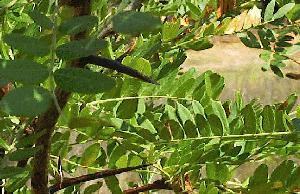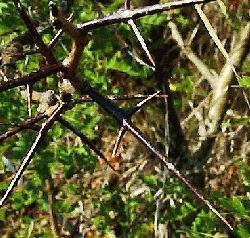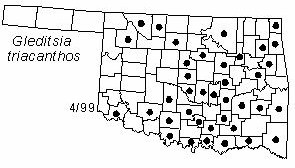

Tree to 20 m (65 ft) tall and 50 cm (20 in) in diameter. Bark blackish to grayish-brown, fissured into long narrow scaly ridges, usually with long sharp branched spines to 20 cm (8 in) long. Twigs thin, usually swollen at the nodes, usually with long sharp-pointed flattened spines, glabrous, shiny-brown. Buds very small, clustered at nodes, no terminal bud. Leaves pinnately or bipinnately compound, 10-20 cm (4-8 in) long, the rachis often with 3-6 pairs of side branches. Leaflets numerous, paired, sessile, oblong, 1-3 cm (0.4-1.2 in) long and half as wide, unequal at base, glabrous shiny dark green above, yellow-green below. Flowers numerous in short clusters at leaf bases, greenish-yellow, about 1 cm (0.4 in) wide, blooming in late Spring. Fruits flat pods to 40 cm (16 in) long and usually about 3 cm (1.2 in) wide, usually twisted or spiraled, not opening, remaining attached until late Fall or early Winter. Seeds beanlike, numerous, about 1 cm (0.4 in) long.
Distribution: Native to the Mississippi Valley westward to eastern Oklahoma, widely escaped from cultivation elsewhere.
Habitat: Floodplain forests, old fields, roadsides.
NWI status: FAC
Comment: Widely planted. It is a poor shade tree, but is hardy and fast-growing. The pods contain a sweet pulp, and are eaten by cattle and wildlife. Gleditsia was named in honor of German botanist J. G. Gleditsch; triacanthos refers to the usually three-branched thorns.
Distribution in Oklahoma: 
BACK
NEXT
RETURN TO INDEX
Last update: 9/10/99
 Go to Oklahoma Biological Survey Home Page
Go to Oklahoma Biological Survey Home Page
 Disclaimer
Disclaimer